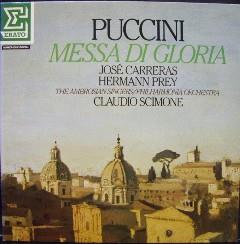Puccini - Messa di Gloria (1984)
Puccini - Messa di Gloria (1984)

A1 Kyrie 5:10 A2 Gloria 20:21 B1 Credo 16:00 B2 Sanctus 3:41 B3 Agnus Dei 2:38 Jose Carreras - tenor Hermann Prey - baryton The Ambrosian Singers Philharmonia Orchestra Conductor - Claudio Scimone
He studied at the nearby Institute Musicale and in 1876 walked twenty miles from Lucca to Pisa and back to hear a performance of Verdi's Aida. It was this experience that finally decided him to pursue a career in the theatre rather than the church. Whilst he was still only eighteen he composed a setting of the mass for choir and orchestra as his graduation piece. It was tc "By this time, however, though he had not announced his decision, Puccini had already chosen the future direction of his career, which was to be in dramatic opera rather than liturgical music. He had been sufficiently eager, during the spring of 1876, to walk the twenty miles from Lucca to Pisa and back for a performance of Verdi's Aida, and it is this experience which seems finally to have decided him on becoming a composer of musical theatre. He said later in life that he \"felt that a musical window had opened for me\". More than a glimpse through that window into the future was offered by Puccini in his graduation exercise for the Pacini Institute, composed to be performed, as had been his earlier motet, on the eve of the Feast of San Paolino, in July, 1880."entitled simply Messa a quattro voci. The first performance in 1880 was a great success, praised by critics and public alike, but Puccini filed it away and it was not heard again in his lifetime.
In 1951 Father Dante del Fiorentino, an émigré Italian priest living in New York who had known Puccini when he was a young curate, was visiting Lucca to collect material for a biography of the composer. He came upon a copy of the mass and on his return home organised the first American performance of it in Chicago in 1952, seventy-two years after its premiere in Lucca. Regrettably, the notes in the preface of the published score perpetuated the fiction claimed by Father Dante that he had ‘rediscovered’ the ‘lost’ manuscript amongst the large collection of Puccini's works held by the family of his musical secretary, Vandini. In fact, the work was never lost; Puccini scholars had always known of its existence and Father Dante was by no means the first to have seen the manuscript. The real reason why it was not performed after its premiere was because Puccini quite clearly intended it to be a farewell to his association with sacred music.
Since its publication in 1951 it has been universally known as the Messa di Gloria and has become a firmly established part of the choral repertoire. It comprises the usual mass sections: Kyrie, Gloria, Sanctus and Benedictus, and Agnus Dei. Puccini uses a standard classical orchestra, with tenor, baritone and bass soloists. The Messa di Gloria is an uncomplicated work. Its style is direct and unashamedly operatic, and it is clearly influenced by Puccini’s hero, Verdi. As a liturgical work written in an overtly operatic style its most obvious antecedents are Rossini’s Petite Messe Solonelle (1863) and Verdi’s Requiem (1874). It is a remarkably assured work for an eighteen-year-old, full of colour, vitality and musical surprises such as the many sudden key changes.
The work’s operatic credentials are not immediately revealed. The Kyrie begins with a luminous string introduction leading to a lyrical ‘Kyrie eleison’. The music becomes more forceful halfway through the ‘Christe eleison’ before returning to the peaceful opening mood.
The Gloria, a real tour de force, takes up nearly half the entire mass, hence the title by which the work has become known. It could easily be performed as a complete work in its own right, and abounds in rhythmic energy, soaring melodies and arresting dramatic gestures. Here Puccini’s operatic instincts are fully expressed. There are several sections, starting with a joyous opening theme that defines the movement. A dramatic tenor solo at 'Gratias agimus' is followed by a reprise of the ‘Gloria in excelsis’ theme, and then for 'Qui tollis' a truly Verdian melody is introduced by the chorus basses. 'Cum sancto spiritu', as custom decreed, is set to an exuberant fugue, the final section of which combines the fugue subject with the opening ‘Gloria’ theme, building to a compelling climax.
Like the Gloria, the Credo is divided into several sections. It begins with strong, unison choral phrases answered by rising orchestral interpolations. A beautiful section for tenor solo and unaccompanied chorus ensues at ‘et incarnatus est’. After an extended bass solo for ‘Crucifixus’ the music explodes into life for the energetic ‘et resurrexit’. The solemn tones of ‘et expecto resurrectionem mortuorum’ usher in the concluding section of the Credo - a surprisingly light and dance-like ‘et vitam venturi’.
The Sanctus is short and simple. The stately opening is followed by a brisk ‘Pleni sunt coeli’ and ‘Hosanna’. The Benedictus is given over to the baritone soloist, the chorus then returning with a brief ‘Hosanna’. The Agnus Dei is also straightforward. A lilting melody for the tenor soloist is answered by the chorus with ‘miserere nobis’. This pattern is repeated with the baritone soloist and finally with both soloists, until the Mass comes to an untroubled close with an innocent triplet phrase. ---John Bawden, choirs.org.uk
download (mp3 @320 kbs):








